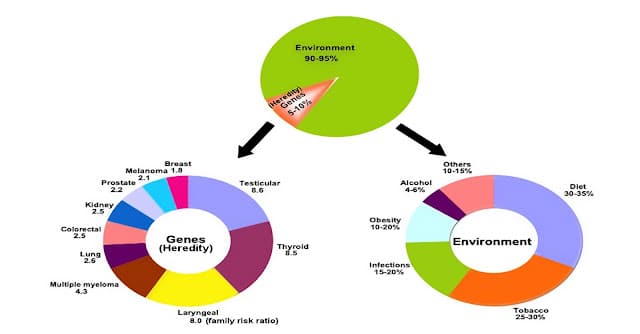Cancer is one of the leading causes of death. At some point in their lives, 39.6 percent of men and women will be diagnosed with cancer, according to the National Cancer Institute.
In addition to genetics, earlier researchers suggest that socioeconomic factors and environmental exposures can also cause cancer. However, by knowing your risks you can help avoid this disease.
Some well-known causes of cancer are poor diet, chronic inflammation, hormonal imbalance, and obesity. Yet, some causes of cancer are not so obvious. Without notice, a few of your seemingly harmless habits can actually increase your risk of cancer.
Most surprising things linked to cancer are:
Food Packaging
Besides our dietary choices, fast food packaging like wrappers and boxes contain perfluorinated chemicals.
These greases- and stain-repellent linings in packaging which are also known as PFCs and PFASs, can easily transfer from the packaging and into food. These chemicals are linked to cancer, impaired immune function, developmental issues to reproductive problems, and other health effects.
Sedentary Lifestyle
TV viewing time, recreational sitting time, occupational sitting time and total sitting time is related to endometrial, lung, and colon cancer. The cancer risk increases with each 2-hour increase in sitting time. Large amounts of time spent in sitting can be dangerous to your health even if you are physically active.
Where You Live
Countries with the poorest quality of water, air, land, built environment, and sociodemographic factors have increased the incidence of cancer. Linked most strongly with high cancer rates is poor air quality and the built environment – the presence of major highways and availability of public transit and housing. Associated with the poor environment is prostate and breast cancer.
Happy Hour
According to a study in 2016, women who increased the amount of alcohol they drank over a five-year period faced a higher risk of breast cancer.
In addition to breast cancer, researchers also linked alcohol to liver cancer, colorectal cancer, esophageal cancer, and head and neck cancer.
Alcohol has these negative effects because our bodies metabolize ethanol (present in alcoholic beverages) into acetaldehyde, which can damage proteins and DNA in the body. Furthermore, alcohol also causes oxidation in the body which causes further damage to DNA, fats, and proteins.
Sawdust
Wood dust is classified as human carcinogens. Furniture workers, as well as other workers exposed to wood dust, are more likely to develop adenocarcinoma, a form of nasal cancer. Hardwood dust such as oak and beech pose the highest risk.
Certain Sunscreens
Sunscreens protect us from sunlight damage that may cause cancer. However, overusing the wrong type of sunscreens has its own risks.
Benzophenone-3 (or oxybenzone) is a common ingredient in sunscreens. It produces free radicals which trigger DNA damage and cancer growth.
Avoid buying sunscreens that contain chemicals like para amino benzoic acid, homosalate, menthyl anthranilate, octocrylene, octyl salicylate, cinoxate, dioxybenzone, oxybenzone, phenylbenzimidazole, methoxycinnamate, and parabens.
Working The Night Shift
Late-night work may increase cancer risk in some people. Our body’s central circadian rhythm, which is also known as the body’s “master clock”, works in response to light and darkness in the environment. Night shifts interfere with the natural rhythm of the body.
Burnt Food
Fried foods are linked to cancer. When foods (like potatoes and toast) are cooked at higher temperatures, it creates a chemical known as acrylamide, which according to studies can damage DNA and cause cancer in animals. Yet, acrylamide has not been directly linked to increased cancer risk in humans.
Aside from acrylamide, burning meat can also increase carcinogens that cause cancer. Cooking meat using store-bought marinades, that contain excess sugar and high-fructose corn syrup, can triple the number of toxins, carcinogenic compounds, and heterocyclic amines (HCAs).
Scented Candles And Air Fresheners
Limonene is a synthetic chemical used to create citrus smells in most scented products. Once this chemical is released into the air, it reacts with ozone, therefore creating formaldehyde – which has been linked to different cancers like nasopharyngeal cancer and myeloid leukemia
Aside from this, fake fragrances are also linked to asthma, hormone chaos, and other serious health issues.
Lack Of Sunlight
A study at Moores Cancer Center at the University of California, San Diego revealed that by increasing levels of Vitamin D3, breast cancer could be prevented worldwide.
The sun is the best source of vitamin D. Just don’t overdo the exposure as too much sunlight can be harmful to the skin.
Viruses And Bacteria
Through a number of studies, the Epstein-Barr virus and HIV are linked to cancer.
The Epstein-Barr virus (EBV) is believed to impact at least 95% of the population. It is commonly known for causing mononucleosis or “mono,” the “kissing disease.” Most people with EBV infections suffer no symptoms. It remains inactive throughout life until triggered by anything from exposure to pesticides and molds.
Researchers conducted a study in 2016 and they found out that breast cells bonded to the Epstein Barr virus and transformed into a more aggressive cancer.
Also, individuals with HIV face a higher risk of developing cervical cancer, Kaposi’s sarcoma, and non-Hodgkin lymphoma.









